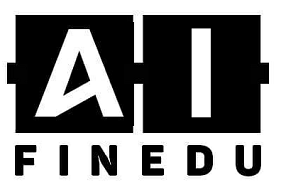Just like Aki (read the previous blog entry), I have had the privilege of wearing an Oura ring for the past week. I have had a couple of activity bracelets and fitness watches before, and the problem that arose (for me) when wearing them was that I was constantly checking whether I had taken enough steps or been active enough during the day. I guess the screen on them made me a bit obsessive about monitoring my activity score. However, they gave me no info whatsoever about whether I had recovered from the gym workout or the run the day before. I was happy as long as I was getting an activity score way above 100% every day. I do know that nowadays, there are many fitness watches that also take recovery into account, but since I never had one, I can only compare the experiences I have had so far with my Oura ring to the ones I had with my previous wearables.
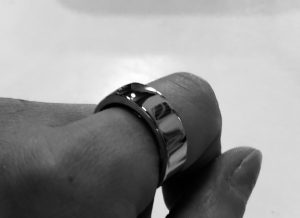
Oura Balance Silver
Workouts for workouts’ sake?
Before I unveiled the elegant Oura Balance Silver from its box, I had lived about a year and a half without any wearables; I got rid of my latest fitness watch because I got frustrated at its inability to give me reliable data about my gym workouts. Apparently, the heart rate sensors in it only worked well when running or cycling (with gps), for instance. In addition, the software that came with the product gave no credit to activities that I had been forced to add manually after the (aforementioned) failed attempts at recording them with the watch. Today, I understand how alarmingly workout-oriented I was, and consequently, how little attention I paid to actually recovering from all the workout load.
When I first laid my hands on my Oura, I just had to “take it out for a ride” like I had done with my previous fitness/activity-tracking devices. I cycled and played tennis for a total of about two hours. At first, I was a bit disappointed at the ring’s inability to give me data regarding my activities; Oura had counted the steps I had taken, but I had to add the activities manually and estimate their intensity (on a scale of easy-moderate-hard). The software then added the info I had provided into the day’s activity score as a completely legitimate activity even though the ring had not been monitoring my heart rate or other factors during exercise. (I was thrilled at this realisation only to realise that my mindset still seemed to be a bit workout-oriented.)
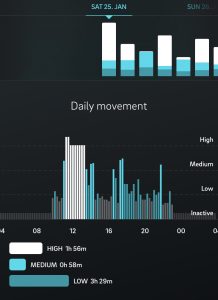
A chart of daily movement and its intensity
All you need is sleep?
Oura does have heart rate sensors, but it only monitors it during sleep and/or moments of relaxation that you decide to take at a point or another during the day. It also monitors variations in your resting heart rate and body temperature, which all contribute to your overall sleeping score and, as a consequence, your readiness score for the next day. The readiness score is something I have already grown very much fond of; no matter how active I have been the previous day, Oura tells me to take it easy if I have not slept well enough for my body to recover from its strains. In addition, it lowers my activity score if I haven’t allowed myself proper rest or days with easier/more moderate workouts.
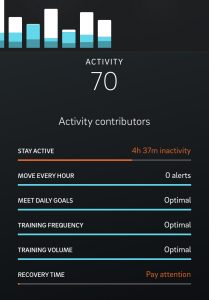
Oura lowers your activity score based on various factors.
In addition to the readiness score being the best PT I have ever had, I have been intrigued by how the ring monitors my sleep. After each night of sleep, the Oura app draws a chart of my resting heart rate and its variability during the night. It also gives me info as for the efficiency of my sleep. The score I get depends on the total hours of sleep, how restful and deep my sleep has been, how long it has taken for me to fall asleep, when I have gone to sleep and woken up, as well as the percentages of each stage of sleep during the night. At the beginning I was very sceptical as for the ring’s ability to monitor my sleep cycle, but as it seems that my REM sleep stages correlate with the peaks in my resting heart rate, I began to trust the data I am getting every morning. Furthermore, after an 8-kilometre run that was a bit too hard/fast for my current physical condition, Oura measured the highest resting heart rate (so far). At this point (if not earlier), I was convinced I was wearing just what I needed for me to start paying more attention to my wellbeing and recovery instead of solely concentrating on the workouts.
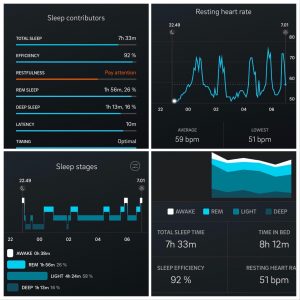
The surprisingly accurate sleep data
Oura and chill?
One more thing I was very sceptical about was how Oura promised to measure the time it takes for me to fall asleep (latency), but it only took one evening of me taking my iPad and Netflix with me to bed and then falling asleep (for what felt like nano-second) while watching it that I realised (when studying my data the next morning) that the ring actually had noticed me dozing off for a second (and then waking up for another to put the iPad away, and then going back to sleep again). Incredible but true – I don’t think I’ll be taking my Oura off any time soon, except for more power (for the ring, that is).
Niina Holopainen, FinEduAI Coordinator
JYK upper secondary school, Joensuu, Finland
Julkaistu kategoriassa

